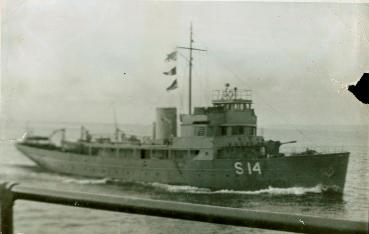The 37-men crew of the HMCS Raccoon perished on this day in 1942 when the armed yacht that served in the Royal Canadian Navy during the Second World War was sunk by a U-165 in the St. Lawrence River.
Raccoon was escorting Convoy QS-33 at the time.
According to Wikipedia, the ship was originally the yacht Halonia, built in 1931 for Charles A. Thorne of Chicago. It was purchased by the RCN in March 1940 , converted to an armed yacht and commissioned that June as HMCS Raccoon. She was assigned to HMCS Fort Ramsay near Gaspé, Quebec in Spring, 1942 to patrol and escort convoys in the river and Gulf of St. Lawrence.
HMCS Raccoon was escorting QS-33 on the evening of Sept. 6 when the merchant ship Aeas was attacked and sunk by U-165 off Cap-Chat. The captain of the lead escort, HMCS Arrowhead, observed the Raccoon zigzagging in search of the submarine. That turned out to be the last time anyone else in the convoy saw the armed yacht.
At 1:12 a.m. on Sept. 7, 1942, two explosions were heard, which the other ships believed were depth charges from the Raccoon. It was only later that it was established that the explosions were the sound of Raccoon’s boiler exploding after being hit by a torpedo from U-165.
While no coins of the Raccoon have been issued to date, the Royal Canadian Mint has celebrated the navy’s role and presence in Canada. In 2010, coins were issued to mark the 100th anniversary of Canada’s navy.
The mint issued seven million one-dollar Canadian Navy Centennial commemorative circulation coins. The coin depicts an serviceman with the 1910 uniform and a female officer with a modern-day uniform, to represent the men and women in Naval service. The ship represented is HMCS Halifax, the lead ship in the Navy’s fleet in 2010. The fouled anchor is part of the centennial identifier image in use to recognize the 100th anniversary of the Navy.
Below are excerpts from an article on Canada’s navy history, as published in the April to June 2010 issue of Canada Post’s Details magazine.
With a country as vast as Canada, it’s easy to forget we’re a maritime nation. But, bordered by three major oceans and home to the largest coastline in the world, our national development has always been shaped by the safety of our waters. For the past century, the men and women of Canada’s naval forces have stood their guard at sea, protecting our country from threats as diverse as terrorism, illegal resource exploitation, pollution violation, narcotics trafficking and illegal immigration.
The Naval Service Act brought the Royal Canadian Navy (RCN) into being on May 4, 1910.
When the First World War broke out, the RCN had less than 350 sailors and two under-equipped warships. By the end of the Second World War, it had grown into one of the world’s greatest naval forces, with roughly 100,000 men and women and a fleet of 365 warships.
Over the years, the RCN—now the Canadian Navy or Maritime Command (MARCOM), the naval element of the Canadian Forces—has served in all the major theatres of war, and has been a great source of pride to Canadians. In particular, the Canadian Navy has been a valuable component of Canada’s contribution to NATO; it has provided humanitarian relief on numerous occasions and has participated in the campaign against terrorism, and in other domestic and international maritime operations.


